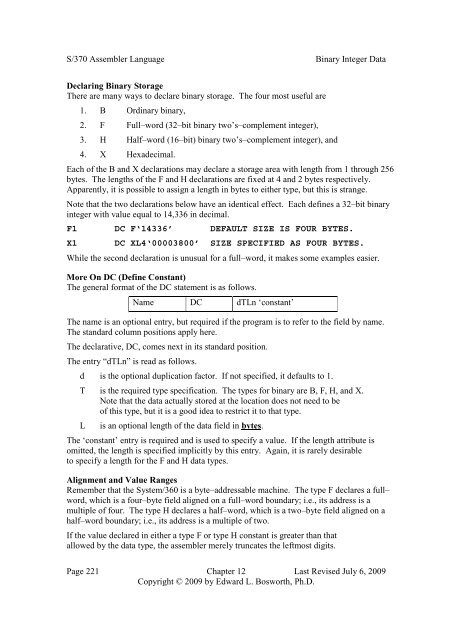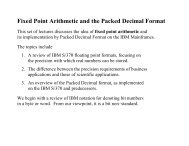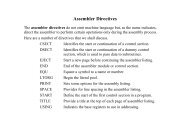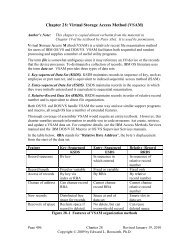PDF Version - Edwardbosworth.com
PDF Version - Edwardbosworth.com
PDF Version - Edwardbosworth.com
You also want an ePaper? Increase the reach of your titles
YUMPU automatically turns print PDFs into web optimized ePapers that Google loves.
S/370 Assembler Language Binary Integer Data<br />
Declaring Binary Storage<br />
There are many ways to declare binary storage. The four most useful are<br />
1. B Ordinary binary,<br />
2. F Full–word (32–bit binary two’s–<strong>com</strong>plement integer),<br />
3. H Half–word (16–bit) binary two’s–<strong>com</strong>plement integer), and<br />
4. X Hexadecimal.<br />
Each of the B and X declarations may declare a storage area with length from 1 through 256<br />
bytes. The lengths of the F and H declarations are fixed at 4 and 2 bytes respectively.<br />
Apparently, it is possible to assign a length in bytes to either type, but this is strange.<br />
Note that the two declarations below have an identical effect. Each defines a 32–bit binary<br />
integer with value equal to 14,336 in decimal.<br />
F1 DC F‘14336’ DEFAULT SIZE IS FOUR BYTES.<br />
X1<br />
DC XL4‘00003800’ SIZE SPECIFIED AS FOUR BYTES.<br />
While the second declaration is unusual for a full–word, it makes some examples easier.<br />
More On DC (Define Constant)<br />
The general format of the DC statement is as follows.<br />
Name DC dTLn ‘constant’<br />
The name is an optional entry, but required if the program is to refer to the field by name.<br />
The standard column positions apply here.<br />
The declarative, DC, <strong>com</strong>es next in its standard position.<br />
The entry “dTLn” is read as follows.<br />
d is the optional duplication factor. If not specified, it defaults to 1.<br />
T is the required type specification. The types for binary are B, F, H, and X.<br />
Note that the data actually stored at the location does not need to be<br />
of this type, but it is a good idea to restrict it to that type.<br />
L<br />
is an optional length of the data field in bytes.<br />
The ‘constant’ entry is required and is used to specify a value. If the length attribute is<br />
omitted, the length is specified implicitly by this entry. Again, it is rarely desirable<br />
to specify a length for the F and H data types.<br />
Alignment and Value Ranges<br />
Remember that the System/360 is a byte–addressable machine. The type F declares a full–<br />
word, which is a four–byte field aligned on a full–word boundary; i.e., its address is a<br />
multiple of four. The type H declares a half–word, which is a two–byte field aligned on a<br />
half–word boundary; i.e., its address is a multiple of two.<br />
If the value declared in either a type F or type H constant is greater than that<br />
allowed by the data type, the assembler merely truncates the leftmost digits.<br />
Page 221 Chapter 12 Last Revised July 6, 2009<br />
Copyright © 2009 by Edward L. Bosworth, Ph.D.


